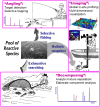The expanding role of electrospray ionization mass spectrometry for probing reactive intermediates in solution
- PMID: 23018925
- PMCID: PMC6268401
- DOI: 10.3390/molecules171011507
The expanding role of electrospray ionization mass spectrometry for probing reactive intermediates in solution
Abstract
Within the past decade, electrospray ionization mass spectrometry (ESI-MS) has rapidly occupied a prominent position for liquid-phase mechanistic studies due to its intrinsic advantages allowing for efficient "fishing" (rapid, sensitive, specific and simultaneous detection/identification) of multiple intermediates and products directly from a "real-world" solution. In this review we attempt to offer a comprehensive overview of the ESI-MS-based methodologies and strategies developed up to date to study reactive species in reaction solutions. A full description of general issues involved with probing reacting species from complex (bio)chemical reaction systems is briefly covered, including the potential sources of reactive intermediate (metabolite) generation, analytical aspects and challenges, basic rudiments of ESI-MS and the state-of-the-art technology. The main purpose of the present review is to highlight the utility of ESI-MS and its expanding role in probing reactive intermediates from various reactions in solution, with special focus on current progress in ESI-MS-based approaches for improving throughput, testing reality and real-time detection by using newly developed MS instruments and emerging ionization sources (such as ambient ESI techniques). In addition, the limitations of modern ESI-MS in detecting intermediates in organic reactions is also discussed.
Figures


References
-
- Turecek F. Transient intermediates of chemical reactions by neutralization-reionization mass spectrometry. Top. Curr. Chem. 2003;225:77–129. doi: 10.1007/3-540-36113-8_3. - DOI
-
- Santos L.S. Online Mechanistic Investigations of Catalyzed Reactions by Electrospray Ionization Mass Spectrometry: A Tool to Intercept Transient Species in Solution. Eur. J. Org. Chem. 2008;2:235–253. doi: 10.1002/ejoc.200700723. - DOI
Publication types
MeSH terms
Substances
Grants and funding
LinkOut - more resources
Full Text Sources
Miscellaneous

